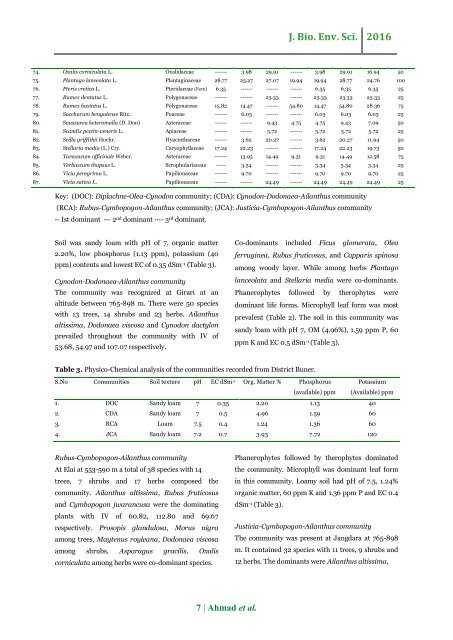Floristic composition and vegetation structure of subtropical pine forest of district Buner, Khyber-Pakhtunkhwa, Pakistan
Deforestation, over-grazing and soil erosion influences vegetation structure of an area. The present study was carried out at District Buner during March, 2012 with the objectives to evaluate the phytosociology of the area. Four stands were selected intentionally and four communities were established on the basis of importance value. The communities were Diplachne-Olea-Cynodon community, Cynodon-Dodonaea-Ailanthus community, Rubus-Cymbopogon-Ailanthus community, Justicia-Cymbopogon-Ailanthus community. A total of 87 plant species have been recognized belonging to 53 families among which 3 species belonging to 3 families of pteridophytes and 8 species belonging to 4 families of monocots. Gymnosperms were represented by a single family Pinaceae with single species Pinus roxburghii while the rest of 75 species distributed among 45 dicots families. Among the families Papilionaceae was observed to be the most diverse. Life form and leaf spectra were also determined.
Deforestation, over-grazing and soil erosion influences vegetation structure of an area. The present study was carried out at District Buner during March, 2012 with the objectives to evaluate the phytosociology of the area. Four stands were selected intentionally and four communities were established on the basis of importance value. The communities were Diplachne-Olea-Cynodon community, Cynodon-Dodonaea-Ailanthus community, Rubus-Cymbopogon-Ailanthus community, Justicia-Cymbopogon-Ailanthus community. A total of 87 plant species have been recognized belonging to 53 families among which 3 species belonging to 3 families of pteridophytes and 8 species belonging to 4 families of monocots. Gymnosperms were represented by a single family Pinaceae with single species Pinus roxburghii while the rest of 75 species distributed among 45 dicots families. Among the families Papilionaceae was observed to be the most diverse. Life form and leaf spectra were also determined.
You also want an ePaper? Increase the reach of your titles
YUMPU automatically turns print PDFs into web optimized ePapers that Google loves.
J. Bio. Env. Sci. 2016<br />
74. Oxalis corniculata L. Oxalidaceae ------ 3.98 29.91 ------ 3.98 29.91 16.94 50<br />
75. Plantago lanceolata L. Plantaginaceae 28.77 23.27 27.07 19.94 19.94 28.77 24.76 100<br />
76. Pteris cretica L. Pteridaceae (Fern) 6.35 ------ ------ ------ 6.35 6.35 6.35 25<br />
77. Rumex dentatus L. Polygonaceae ------ ------ 23.33 ------ 23.33 23.33 23.33 25<br />
78. Rumex hastatus L. Polygonaceae 15.82 14.47 ------ 54.80 14.47 54.80 28.36 75<br />
79. Saccharum bengalense Ritz. Poaceae ------ 6.03 ------ ------ 6.03 6.03 6.03 25<br />
80. Saussurea heteromalla (D. Don) Asteraceae ------ ------ 9.43 4.75 4.75 9.43 7.09 50<br />
81. Sc<strong>and</strong>ix pectin-veneris L. Apiaceae ------ ------ 5.72 ------ 5.72 5.72 5.72 25<br />
82. Scilla griffithii Hochr. Hyacinthaceae ------ 3.62 20.27 ------ 3.62 20.27 11.94 50<br />
83. Stellaria media (L.) Cry. Caryophyllaceae 17.24 22.23 ------ ------ 17.24 22.23 19.73 50<br />
84. Taraxacum <strong>of</strong>ficinale Weber. Asteraceae ------ 13.95 14.49 9.31 9.31 14.49 12.58 75<br />
85. Verbascum thapsus L. Scrophulariaceae ----- 3.34 ------ ------ 3.34 3.34 3.34 25<br />
86. Vicia peregrima L. Papilionaceae ------ 9.70 ------ ------ 9.70 9.70 9.70 25<br />
87. Vicia sativa L. Papilionaceae ------ ------ 24.49 ------ 24.49 24.49 24.49 25<br />
Key: (DOC): Diplachne-Olea-Cynodon community; (CDA): Cynodon-Dodonaea-Ailanthus community<br />
(RCA): Rubus-Cymbopogon-Ailanthus community; (JCA): Justicia-Cymbopogon-Ailanthus community<br />
*- Ist dominant **- 2 nd dominant ***- 3 rd dominant.<br />
Soil was s<strong>and</strong>y loam with pH <strong>of</strong> 7, organic matter<br />
2.20%, low phosphorus (1.13 ppm), potassium (40<br />
ppm) contents <strong>and</strong> lowest EC <strong>of</strong> 0.35 dSm -1 (Table 3).<br />
Cynodon-Dodonaea-Ailanthus community<br />
The community was recognized at Girari at an<br />
altitude between 765-898 m. There were 50 species<br />
with 13 trees, 14 shrubs <strong>and</strong> 23 herbs. Ailanthus<br />
altissima, Dodonaea viscosa <strong>and</strong> Cynodon dactylon<br />
prevailed throughout the community with IV <strong>of</strong><br />
53.68, 54.97 <strong>and</strong> 107.07 respectively.<br />
Co-dominants included Ficus glomerata, Olea<br />
ferruginea, Rubus fruticosus, <strong>and</strong> Capparis spinosa<br />
among woody layer. While among herbs Plantago<br />
lanceolata <strong>and</strong> Stellaria media were co-dominants.<br />
Phanerophytes followed by therophytes were<br />
dominant life forms. Microphyll leaf form was most<br />
prevalent (Table 2). The soil in this community was<br />
s<strong>and</strong>y loam with pH 7, OM (4.96%), 1.59 ppm P, 60<br />
ppm K <strong>and</strong> EC 0.5 dSm -1 (Table 3).<br />
Table 3. Physico-Chemical analysis <strong>of</strong> the communities recorded from District <strong>Buner</strong>.<br />
S.No Communities Soil texture pH EC dSm -1 Org. Matter % Phosphorus<br />
(available) ppm<br />
Potassium<br />
(Available) ppm<br />
1. DOC S<strong>and</strong>y loam 7 0.35 2.20 1.13 40<br />
2. CDA S<strong>and</strong>y loam 7 0.5 4.96 1.59 60<br />
3. RCA Loam 7.5 0.4 1.24 1.36 60<br />
4. JCA S<strong>and</strong>y loam 7.2 0.7 3.93 7.72 120<br />
Rubus-Cymbopogon-Ailanthus community<br />
At Elai at 553-590 m a total <strong>of</strong> 38 species with 14<br />
trees, 7 shrubs <strong>and</strong> 17 herbs composed the<br />
community. Ailanthus altissima, Rubus fruticosus<br />
<strong>and</strong> Cymbopogon jwarancusa were the dominating<br />
plants with IV <strong>of</strong> 60.82, 112.80 <strong>and</strong> 69.67<br />
respectively. Prosopis gl<strong>and</strong>ulosa, Morus nigra<br />
among trees, Maytenus royleana, Dodonaea viscosa<br />
among shrubs, Asparagus gracilis, Oxalis<br />
corniculata among herbs were co-dominant species.<br />
Phanerophytes followed by therophytes dominated<br />
the community. Microphyll was dominant leaf form<br />
in this community. Loamy soil had pH <strong>of</strong> 7.5, 1.24%<br />
organic matter, 60 ppm K <strong>and</strong> 1.36 ppm P <strong>and</strong> EC 0.4<br />
dSm -1 (Table 3).<br />
Justicia-Cymbopogon-Ailanthus community<br />
The community was present at Jangdara at 765-898<br />
m. It contained 32 species with 11 trees, 9 shrubs <strong>and</strong><br />
12 herbs. The dominants were Ailanthus altissima,<br />
7 | Ahmad et al.


















